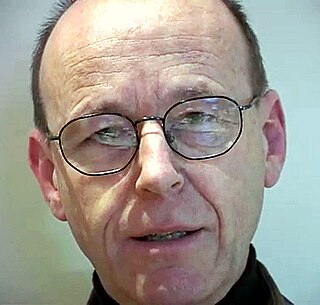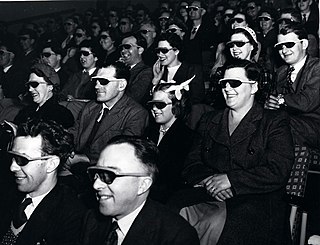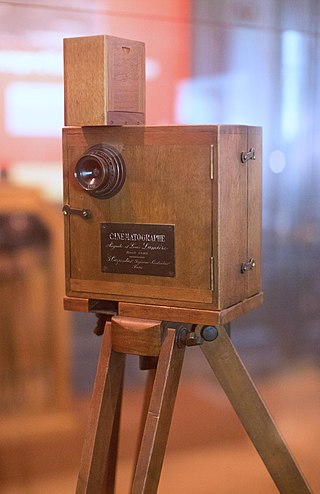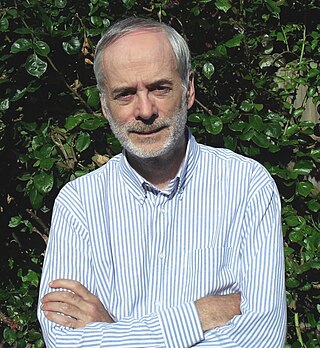The history of film chronicles the development of a visual art form created using film technologies that began in the late 19th century.

Stephen and Timothy Quay are American identical twin brothers and stop-motion animators who are better known as the Brothers Quay or Quay Brothers. They received the 1998 Drama Desk Award for Outstanding Set Design for their work on the play The Chairs.

The National Science and Media Museum, located in Bradford, West Yorkshire, is part of the national Science Museum Group in the UK. The museum has seven floors of galleries with permanent exhibitions focusing on photography, television, animation, videogaming, the Internet and the scientific principles behind light and colour. It also hosts temporary exhibitions and maintains a collection of 3.5 million pieces in its research facility.

The British Film Institute (BFI) is a film and television charitable organisation which promotes and preserves film-making and television in the United Kingdom. The BFI uses funds provided by the National Lottery to encourage film production, distribution, and education. It is sponsored by the Department for Culture, Media and Sport, and partially funded under the British Film Institute Act 1949.
John Smith is a British avant garde filmmaker noted for his use of humour in exploring various themes that often play upon the film spectator's conditioned assumptions of the medium.
ACMI, formerly the Australian Centre for the Moving Image, is Australia's national museum of screen culture including film, television, videogames, digital culture and art. ACMI was established in 2002 and is based at Federation Square in Melbourne, Victoria.
Jane Wilson and Louise WilsonRA Elect are British artists who work together as a sibling duo. Jane and Louise Wilson's art work is based in video, film and photography. They are YBA artists who were nominated for the Turner Prize in 1999.

Anthony McCall is a British-born New York based artist known for his ‘solid-light’ installations, a series that he began in 1973 with "Line Describing a Cone," in which a volumetric form composed of projected light slowly evolves in three-dimensional space.
David John Francis is a British film archivist. He was the second curator of the UK's National Film and Television Archive from 1974 until 1989, when he was succeeded by Clyde Jeavons. Francis went on to become the Chief of the Motion Picture, Broadcasting and Recorded Sound Division at the Library of Congress.
Arthur Melbourne Cooper was a British photographer and early filmmaker best known for his pioneering work in stop-motion animation. He produced over three hundred films between 1896 and 1915, of which an estimated 36 were all or in part animated. These include Dreams of Toyland (1908) and according to some sources Dolly’s Toys (1901), as well as Matches: An Appeal, which Dutch independent researcher Tjitte de Vries has claimed may have been the first animated film to be shown in public.
Jesse Leslie Hardcastle OBE was a British arts administrator who was controller of the British Film Institute's (BFI) National Film Theatre (NFT) complex on London's South Bank from its early beginnings through to his retirement in the mid 1990s.

The BFI National Archive is a department of the British Film Institute, and one of the largest film archives in the world. It was founded as the National Film Library in 1935; its first curator was Ernest Lindgren. In 1955, its name became the National Film Archive, and, in 1992, the National Film and Television Archive. It was renamed BFI National Archive in 2006.

The Telecinema was a small cinema built especially for the Festival of Britain's London South Bank Exhibition in the summer of 1951. It was situated between Waterloo station and the Royal Festival Hall.

A film – also called a movie, motion picture, moving picture, picture, photoplay or (slang) flick – is a work of visual art that simulates experiences and otherwise communicates ideas, stories, perceptions, feelings, beauty, or atmosphere through the use of moving images. These images are generally accompanied by sound and, more rarely, other sensory stimulations. The word "cinema", short for cinematography, is often used to refer to filmmaking and the film industry, and the art form that is the result of it.

BFI Southbank is the leading repertory cinema in the UK, specialising in seasons of classic, independent and non-English language films.
In addition to published work on cinema, this article also includes Denis Gifford's film credits.

The history of film technology traces the development of techniques for the recording, construction and presentation of motion pictures. When the film medium came about in the 19th century, there already was a centuries old tradition of screening moving images through shadow play and the magic lantern that were very popular with audiences in many parts of the world. Especially the magic lantern influenced much of the projection technology, exhibition practices and cultural implementation of film. Between 1825 and 1840, the relevant technologies of stroboscopic animation, photography and stereoscopy were introduced. For much of the rest of the century, many engineers and inventors tried to combine all these new technologies and the much older technique of projection to create a complete illusion or a complete documentation of reality. Colour photography was usually included in these ambitions and the introduction of the phonograph in 1877 seemed to promise the addition of synchronized sound recordings. Between 1887 and 1894, the first successful short cinematographic presentations were established. The biggest popular breakthrough of the technology came in 1895 with the first projected movies that lasted longer than 10 seconds. During the first years after this breakthrough, most motion pictures lasted about 50 seconds, lacked synchronized sound and natural colour, and were mainly exhibited as novelty attractions. In the first decades of the 20th century, movies grew much longer and the medium quickly developed into one of the most important tools of communication and entertainment. The breakthrough of synchronized sound occurred at the end of the 1920s and that of full color motion picture film in the 1930s. By the start of the 21st century, physical film stock was being replaced with digital film technologies at both ends of the production chain by digital image sensors and projectors.
Sarah Pucill is a London-based film artist. Her work is distributed by LUX, London and LightCone, Paris. She is a Reader at University of Westminster. Central to her work is "a concern with mortality and the materiality of the filmmaking process". Much of her work appears within the restrictions of domestic spaces. In her "explorations of the animate and inanimate, her work probes a journey between mirror and surface".
The Kent Museum of the Moving Image opened in Deal, Kent in April 2018. The museum was created by David Francis, with his wife Jocelyn Marsh. Francis was one of the lead members who created the Museum of the Moving Image in London.

Stephen Herbert (1951-2023) was a British visual media historian, author, editor, publisher and projectionist. He was head of technical services at the National Film Theatre and the Museum of the Moving Image.














